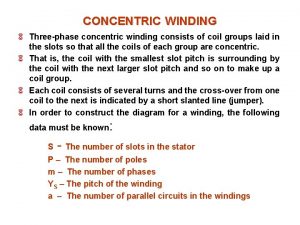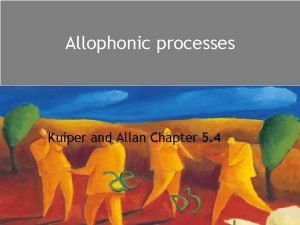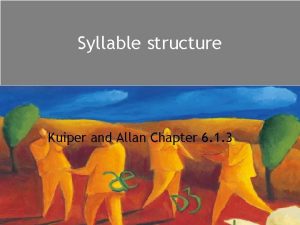Pitch and intonation Kuiper and Allan Chapter 6












- Slides: 12

Pitch and intonation Kuiper and Allan Chapter 6. 2

Pitch • People only rarely speak on a monotone. • Pitch changes take two forms in languages: – phonemic in tone languages – intonational in all languages

Creating pitch • Pitch is created by the rate of vibration of the vocal cords. • You can make your vocal cords vibrate at different rates when you sing. • You have a natural pitch span or pitch range when speaking.

Exercise Say the following first as a statement and second as a question. Listen carefully for the pitch of your voice at the end of the utterance. You left the train.

Intonation • is created by pitch movements. • Intonation is suprasegmental in that it is an overlay over the segmental phoneme sequence.

Tones • When the pitch of the voice changes during the production of a syllable we are hearing a tone. • Types of tones: – – falling rise fall rise $ € fl ‡

Exercise Listen to the following sentence and see if it divides intonational sections. How many tones does each section have? After eating her breakfast, Joanna went out.

Tone groups • Speech is divided into tone groups. • Each tone group has one tonic syllable in which there is a tone.

An analogy • Think of speaking as rather like singing where each syllable has a note. • A tone group is a musical phrase. • The nuclear tone involves a pitch change on the syllable; all other syllables are sung without a change in pitch.

The musical notation of intonation • The normal pitch range • A tone group Are you at home

Where are tone group boundaries? • In continuous speech tone group boundaries tend to come at grammatical phrase boundaries. • The tonic syllable (the one having the pitch change) is usually the last stressed syllable in the tone group. • Tone group boundaries are marked by a vertical slash in a text.

The functions of intonation • attitudinal I’ll see you behind the bike sheds afterwards. You? • accentual – contrastive stress I want a big icecream. • grammatical Those who work slowly get to the top.
 Rising or falling intonation
Rising or falling intonation Back pitch and front pitch
Back pitch and front pitch Coil pitch and pole pitch
Coil pitch and pole pitch Ac motor armature winding diagram
Ac motor armature winding diagram Cyclic pitch vs collective pitch
Cyclic pitch vs collective pitch Sieder tate equation
Sieder tate equation Propeller helix angle
Propeller helix angle Baseball parent meeting agenda
Baseball parent meeting agenda Kuiper belt def
Kuiper belt def Koenraad kuiper gender theory
Koenraad kuiper gender theory Thomas gordon theory
Thomas gordon theory Pilar santiago
Pilar santiago Kuiper cliff
Kuiper cliff























